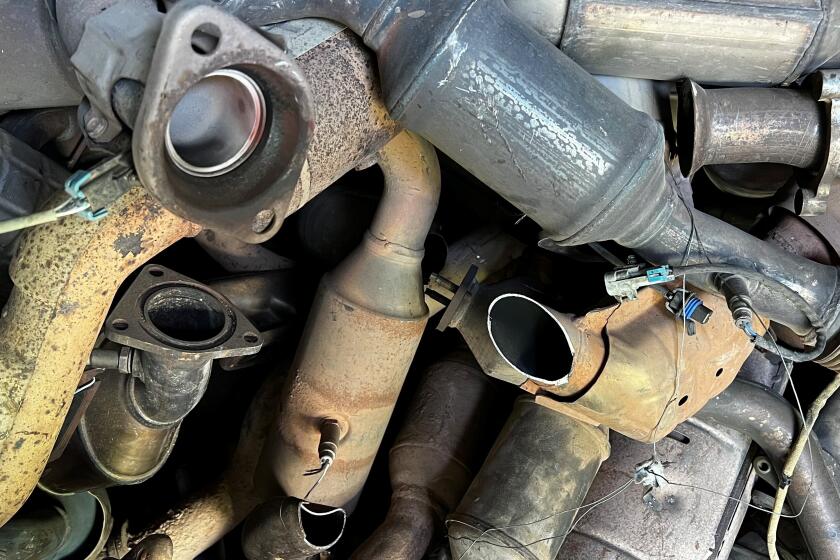Felony charges filed against UC and a UCLA chemistry professor after fatal laboratory fire
- Share via
Felony charges have been filed against the University of California and a UCLA chemistry professor in connection with a laboratory fire that killed a staff research assistant three years ago.
On Dec. 29, 2008, Sheharbano “Sheri” Sangji, 23, was severely burned over nearly half of her body when air-sensitive chemicals burst into flames during an experiment and ignited her clothing. Sangji, who was not wearing a protective lab coat, died 18 days later.
Her death raised questions about lab safety practices at UCLA and about Sangji’s training and supervision by professor Patrick Harran, a prominent researcher who joined the faculty in July 2008.
On Tuesday, the Los Angeles County district attorney’s office charged Harran and the UC regents with three counts each of willfully violating occupational health and safety standards, resulting in Sangji’s death. Harran and UCLA are accused of failing to correct unsafe work conditions in a timely manner, to require clothing appropriate for the work being done and to provide proper chemical safety training.
An arrest warrant was issued for Harran, 42, who faces up to 41/2 years in state prison, according to a district attorney’s spokeswoman. Harran is out of town and will surrender to authorities when he returns, said his lawyer, Thomas O’Brien, who declined to comment further.
UCLA could be fined up to $1.5 million on each of the three counts. In separate statements Tuesday, UCLA and the regents called the charges unwarranted. UCLA’s statement blasted them as “outrageous” and “appalling.”
“This isn’t justice,” Kevin Reed, UCLA vice chancellor for legal affairs, said in an interview. “What happened in December 2008 was a tragedy, an unfathomable tragedy. It was not a crime.”
Sangji’s family, led by her older sister Naveen, has been harshly critical of UCLA officials and the California Division of Occupational Safety and Health’s investigations. Naveen Sangji said Tuesday that she hopes the criminal case goes to trial so her family “has the opportunity to speak to the court” about what happened to her sister.
“As we have been saying all along, the filing of charges is the first step toward any kind of justice for what Harran and UCLA did to our family,” she said. “It won’t bring Sheri back, but we do hope this will help keep other young people safe and keep other families from being destroyed.”
Born and raised in Pakistan, Sheri Sangji graduated in 2008 from Pomona College in Claremont and planned to become a lawyer. While applying to law schools, she took a $46,000-a-year job in a lab run by Harran, a researcher with a rising reputation in organic chemistry.
Sangji was transferring up to two ounces of t-butyl lithium from one sealed container to another when a plastic syringe came apart in her hands, spewing a chemical compound that ignites when exposed to air. The synthetic sweater she wore caught fire and melted onto her skin, causing second- and third-degree burns.
“I cannot describe the level of grief my family has experienced having witnessed the excruciating pain our Sheri suffered in those horrifying days at the burn center — and then losing her forever,” Naveen Sangji said.
In May 2009, Cal/OSHA fined UCLA a total of $31,875 after finding that Sangji had not been trained properly and was not wearing protective clothing.
“Sheri was an experienced chemist and published researcher who exuded confidence and had performed this experiment before in my lab,” Harran said in a statement at the time.
Two months before the fatal fire, UCLA safety inspectors found more than a dozen deficiencies in the same lab, according to internal investigative and inspection reports reviewed by The Times. The inspectors found that employees were not wearing requisite protective lab coats and that flammable liquids and volatile chemicals were stored improperly.
But the required corrective actions were not taken before the fatal fire, the records showed.
In response to Sangji’s death, UCLA instituted a host of safety improvements, including more rigorous lab inspections, more flame-resistant lab coats and enhanced training in the use of safety gear and the handling of air-sensitive chemicals. UCLA also established a Center for Lab Safety.
Tuesday’s charges are thought to be the first stemming from an academic lab accident, said Russ Phifer, executive director of the National Registry of Certified Chemists and former head of the American Chemical Society’s safety division. Phifer said his research turned up only one other criminal case, and it involved a commercial lab in the 1980s.
He said the Sangji case not only led to UCLA’s improvements but has had a “monster effect” on academic laboratory safety nationwide.
“It is probably the single most significant event in getting people’s attention,” he said. “It is unfortunate, but there is nothing like an accident — an injury or a death, and all that it entails — to get people’s attention.”
More to Read
Sign up for Essential California
The most important California stories and recommendations in your inbox every morning.
You may occasionally receive promotional content from the Los Angeles Times.











